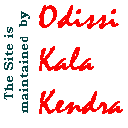Odissi
is the classical dance form that originated in the
ambience of the temples. It is a lyrical form of
dance with its subtelety as its keynote. The intimate
relationship experienced between the poetry and music
in Odissi is a feature on which the aesthetics of the
style is built. It is a "sculpturesque"
style of dance with a harmony of line and movement,
all its own.
The
history of Odissi dates back to somewhere between the
8th and the 11th century, when the kings took great
pride in excelling in the arts of dance and music. It
is during these centuries that inscriptions referring
to "Devdasis", the women who were
conseciated to the worship of the deity, were carved
at the Brahmeshwar temple. "Devdasis"
apparently played an important part in the temple
ritual and were required to perform from early
evening to the bedtime of Lord Jagannath, the temple
deity of Puri.
Jayadeva's
"Geeta-Govinda", the bible of an
Odissi dancer, written in the 12th century, has
stupendous influence on the arts of Orissa. The "Ashtapadis"
were marked with specific ragas and talas.
Around the 15th century, during the reign of Surya
Dynasty, the element of "abhinaya" or
expressional dance entered Odissi. During the same
time Maheshwar Mahapatra wrote his "Abhinaya
Chandrika", an elaborate treatise on Odissi
dance style, and today, the basic to any study of it.
By the 16th century, there were three kinds of
dancers in Orissa: the "Maharis" in the
temples, the "Nachunis" in the royal court,
and the "Gotipuas" in the gymnasiums - who
performed for the public. The religious revival of
the 18th century saw a return of temple patronage to
the arts. But the "Maharis" were slowly
disappearing and their place was being taken by the
"Gotipuas", young boys dressed as girls.
These boys were trained in physical culture in the
"Akhadas", and it was them who preserved
the basic for restructuring of the ancient dance
tradition.
The technique of Odissi is
based upon the "Chowka", a manly posture,
and the weight of the body is distributed equally on
both the sides. It is the posture of Lord Jagannath
of Puri and reflects the balanced, all-encompassing
and universal quality of "dharma" of Lord
Jagannath. It is a "Sambhanga" or equally
distributed position in terms of weight.
Next
comes the "Abhanga" position, in which body
weight is displaced to any one side due to deflection
of one or the other knee, in either standing or half
sitting posture.
Then
comes the "Tribhanga" position, the
three-bend posture, in which a series of triangles
are formed in the body. The bends are made at the
knees, the torso and the neck. It is an extremely
feminine posture represented in sculptures of female
figures and is based upon the Hindu concept of
iconography.
What
is interesting about Odissi is that body position is
not merely a part of the vocabulary or frame-work.
The posture by itself conveys a particular mood or
message. The names of these postures too express the
moods they represent.
The verses used by the Odissi
dancer for narration are extremely ornate in content
and suggestion. The finest example of these are of
course, the "Ashtapadis" of the
"Geeta-Govinda". Several considerations
would contribute to the delineation of these items
for expressions in dance. They would mainly involve
the spiritual and devotional aspect on one hand, and
the "Sringara" (the aspect of love) on the
other hand. Quite simply, this could signify the
human element in God and the element of Godliness in
man. The "Abhinaya" in Odissi is evocative
and classical in its stylization and is often
interspersed with "Nritta" (the pure
dance), which interludes as connecting link between
two verses or ideas.
Items presented for an Odissi
recital form a pattern of development which is both
physically practical and also aesthetic. The "Mangalacharan"
is an offering made at the start of the programme. "Rangamancha-pravesh"
is the entry on to the stage with floral
offering. "Rangabhumi pranam" is
thr salutation to the stage and the earth, and is the
first concept or idea. This is followed by the "Ishtadeva
vandana" - an obeisance made to the
dancers' favourite deity. The "Trikhandi-pranam"
follows, where salutations are made to the goda, the
guru, and the audience, thus concluding the item with
"Anjali-hasta" - a gesture of
greetings and devotion.
The "Batu"
is an item of pure dance that is derived from the
influence of the Tantric worship of Balukeshwar
Bhairav, an aspect of Lord Shiva. The "Pallavi"is
an elaboration of both dance and music. "Abhinaya"
comes next, involving enactment of a lyric, followed
by the concluding item "Moksha"
which is liberation - which is the main aim of life
and possibility of attaining is through devotional
practice of the art of dance.
The costume of the Odissi
dancer is a silk saree draped in a practical and
comfortable style. The wears the head ornament called
the "Mathami", "Kapa" on
the ears, "Kankana" on the wrists,
armlets called "Bahichudi" or "Tayila"
and an elaborate belt. She wears on her ankles bells
strung together on a single cord. A "Padaka-tilaka",
a necklace with a locket rests on the chest. An
Odissi dancer has elaborate hair-do in a knot adorned
with the "Tahiya" which represents
a temple tower. Garlands of flowers are woven into
the hair. Palms and soles are painted with a red
liquid called the "Alta".
The
musicians accompanying the dancer are mainly the
pakhawaj players, the flutist, and a singer.
Dance
is an expression of man's joy through rhythmic and
spontaneous movements. This pure expression and
energy, when put in a classical mould must strictly
adhere to the codes of a systematized technique, and
Odissi bases itself on a wealth of such techniques
which make this dance aesthetically appealing and
visually delightful.
